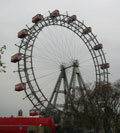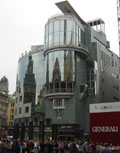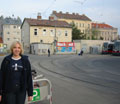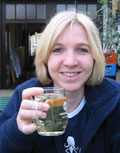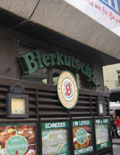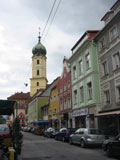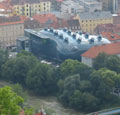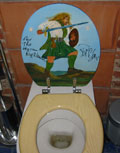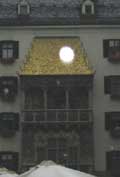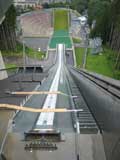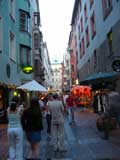| How would you like to view this page? | ||
|
Jump To:
See Also:
|
(Based
on a quick weekend in Innsbruck, July 2004. a trip to Vienna &
Mattersburg in April 2005, |
 |
My first visit to Austria was literally "in passing" - a total of 7 hours spent at Vienna Airport in transit to and from Sarajevo in 1999. My abiding memory is of Austrian Airlines stewardesses in their all-red uniforms (complete with stockings!). Eventually, we decided to take advantage of cheap direct flights from Gatwick to Innsbruck. Why not Vienna first? Well, we thought about it, but it meant nothing to me... Spring 2005 did bring about a trip to Vienna and Mattersburg (in the rural Burgenland province), and with trips to Graz (August 2005) and Salzburg (October 2005, on the way home from Slovenia) on the cards, expect this guide to grow nicely in time for Euro 2008! The main thing to remember in this German speaking country is that you are NOT in Germany! (Easier said than done, believe it or not). The Tirol in particular is very similar to Bavaria, in terms of ambience, folk traditions and dialect. The easiest way to remember is that the beer is not quite as good (and is slightly more expensive). |
|
|
I’d never been in any rush to go to the Austrian capital previously, mostly due to my preconceptions about stuffiness and powdered wigs. Nonetheless, when the time came, we were very pleasantly surprised. The café culture, complete with tuxedoed waiters, can be a little starched, but this is completely offset by the lively, cheap heurigen taverns. We spent a pretty active three days there, but could happily go back and still find loads of new things to do. |
|
|
Arrival in Vienna (and the wonders of a Vienna Card!) I wouldn’t normally be quite so prescriptive, but… this really is the way to do it if you arrive at Schwechat Airport (VIE)! When you clear passport control, search out the Tourist Office – it faces into the baggage reclaim area, but if you miss it, it has a window onto the Arrivals Hall (come out into the landside area and turn sharp right). Buy a Vienna Card (was just under 17 Euros when were there) – this is a 72-hour discount and public transport ticket, and is WELL worth the cash. For a start, it gets you a 17% on the first-class CAT (City Airport Train) high-speed link to central Vienna (Wien Mitte station) – either buy your CAT tickets at the same time, or pick them up on the train (each carriage has a conductor checking tickets). If you use the machine you won’t get the discount. Once you arrive at Wien Mitte station, walk along to the main S-Bahn/U-Bahn connections at Landstrasse (all under the same roof), stamp your Vienna Card in the ticket machines by the platform escalators (very important!), and that’s you covered for 72 hours public transport. There are other ways into town (S-Bahn 7, Taxi and bus – the last two offer a 17% discount with the Card as well), but none are the bargain in terms of speed/cost that the CAT is. And if that’s not enough convincing, did I mention it was a double-decker train? |
||
For a place with such a stuffy reputation, Vienna is really packed with sights. It really would take a full week or more to really see and do everything, so pick and choose your favourites carefully. This was our pick of the attractions (many of which were discounted through the Vienna Card):
|
|
|
Heuriger I would really, really recommend taking a step into the unknown and visiting one of the heuriger areas on the outskirts. We opted for Stammersdorf, an easy half-hour tram ride (number 31) from Schottenring right to the terminus (one street south of where the action is). It really is wall-to-wall wine taverns on Stammersdorfer Strasse, ranging from the small, family-run affairs through to larger places with seating and tables in large courtyard gardens. The unifying feature of these taverns is the school canteen style catering – grab a tray, join the queue and ask for (or point at) what you want. The wine, on the other hand, is almost always ordered and served by a waitress. The Stammersdorf heuriger we visited (three different ones) did not have live music or gimmicks, but by all accounts those in the more-touristed Grinzing suburb are (although these are frowned on by many of the locals due to the number of tour buses passing through).
Pubs
There’s also a good spread of pubs in the streets due north of Neubaugasse U-Bahn (right up to Siebensternbrau and beyond), but we didn’t go in any as we had focussed on heuriger more than originally planned! Although I do wish I’d known about this really handy web site before we went. |
|
|
Having fallen in love with Innsbruck, and been incredibly impressed with Vienna, we were looking forward to Graz but felt it had a lot to live up to. It managed this and more – it’s a superb destination for a city break on a cosy scale. Graz is Austia’s second city, and has been cruelly overlooked for Euro 2008, despite having two well-supported, successful clubs (Strum Graz and Grazer AK). The city is home to tens of thousands of students, which give a young and trendy edge to the olde worlde red-oofed and cobble-streeted altstadt. The Styrian province (of which Graz is the capital) is famed for it’s cuisine, which relies heavily on pumpkin oil, and is also famed within Austria for its wines (the tourist office arranges wine-tasting trips in summer). Finding your way around is simple enough – the Schlossberg (Castle Hill) towers over the city centre and is a good point of reference. The Altstadt area is bordered on the west by the narrow Mur River, which flows rapidly from south to north, and on the east slopes up to the cathedral and some of the older buildings. The town hall is the imposing building on the south edge of the Hauptplatz (Main Square), and the superbly named Arnold Schwarzenegger Stadium is roughly two miles due south from here (which may soon be changing name after a fall out with The Terminator). The station is to the west of the centre in a flat and relatively uninteresting part of town. |
|
|
Graz is a great place to see the Austrian fascination with incongruous juxtapositions up close, with a real mix of the traditional and the modern. Some people (like Helen) hate it; I love it!
|
|
|
It's fair to say this is one city you won't go thirsty. And if you did, the Puntigamer brewery is on the outskirts of town to boot!
|
|
|
Innsbruck has a stunning setting in a valley between two mountain ranges, and is a main junction between Bavaria and Northern Italy, sitting as it does on the Brenner Pass. It's quite a large town in population size, but is very walkable. Even the airport is in the city limits and only a few miles from the old town. We were there in Summer, when it seems to be very popular with Italian tourists, including hen parties - I'm sure it takes on more of a ski resort ambience in winter, but as that's not really our bag, it would be unfair to comment. |
|
|
Things to Do & See in Innsbruck There is more than enough to fill a weekend, but we can really recommend getting hold of an Innsbruck Card (the Tourist Board site for details) - at €21 for 24 hours, we still saved loads. Almost everything is free with it, and you don't need to worry about transport fares either.
|
|
|
Happily, there is no shortage of quality places to kick back and have a beer in Innsbruck, ranging from the down and dirty to the posh and swanky. The Altstadt has seveal options, but it's definitely worth exploring the bars in the railway arches north of the main station. Here are some we can personally recommend:
|
|
|
Whilst not as stunningly set as Innsbruck, sleepy Salzburg still has its attractions, such as the massive hill range from which the castle surveys the town. The castle can be reached on foot via stairs, a winding cobbled road or an obscenely over-priced Festungsbahn funicular railway. To be honest, I’d rank it fourth behind Vienna, Graz and Innsbruck, but then again Helen disagrees and she loved the place. We only had 25 hungover hours appreciate the charms of Salzburg, so this is partly a list of what we would have done, had we had the time… Altstadt – Salzburg’s winding, narrow altstadt streets bear some investigating, although they can get crowded at busy times (such as during the Christmas markets). It’s possible to ride around it in a horse and cart, should you have no qualms about staring at a horse’s backside. Brauwelt – The Stiegl brewery boasts the largest beer display in Europe, but let’s face it, you’re only after the free tasting! Now open year-round, this is a fair hike out of the centre and halfway towards the airport. Festungsbahn – over-priced and over-popular funicular railway up to the castle. Dom – stands over Domplatz in the centre, and like other Austrian cathedrals, far more spectacular from the inside. Zipfer Bierhaus – popular restaurant (only a couple of stand up drinking tables!) in the altstadt. Either book or come early. Braumeister Pub – part of the extensive Sternbrau bar and restaurant complex, the smaller and more intimate Braumeister boasts a cosy atmosphere and an impressive range of Austrian beer. Also makes a nice change from the ubiquitous Stiegl. Stiegl Kellar – speaking of which… the Stiegl Kellar occupies a prime piece of real estate, overlooking Domplatz at the foot of the road up to the castle (and just 50 yards past the funicular ticket office). Stiegl is an old-school beer hall – up the stairs and left for the drinking bits (and the summer terrace with cheap self-service beer), or right for the fancier restauranty bits. Weisses Kreuz Kellar – Austrian-Balkan fusion cuisine, apparently. We wouldn’t know as it’s insanely popular and was fully booked. Worth a look, by all accounts. St Paul’s Stub’n – another fully-booked place (how do you think we managed to cover so many restaurants in 25 hours?), this poky room is upstairs and just around the corner from Weisses Kreuz. |
||
Mattersburg is home to Burgenland’s top football team, SVM, and the stadium is capable of holding the town’s entire 6,000 population with room for a couple of thousand of their pals to boot! The town’s main tourist attraction is its lovely railway viaduct (I kid you not), and handily for any hybrid train/stadium spotters, it is slap band next to said football stadium. The main station, with one of the skinniest platforms in Europe (one abreast) has a handy pub, and is around 10 minutes uphill from the town centre. The primary hotel, the Florianihof, is very comfortable and has a restaurant and bar (the bar also serves as the reception). A handful of bars compete for your attention, including a sports pub on the way to the ground, and unbelievably, and Irish pub called The Peacock, staffed by nubile Hungarian beauties. The football club bar is apparently a focal point of weekend nightlife, which isn’t too surprising when it knocks out top-notch local wine at 1 Euro a glass! A nice wee place, but somewhere you’re unlikely to find yourself in without a reason. You might see it out the train window if you ever make the trip from Vienna to the Hungarian shopping town of Sopron. |
|
|
I’d never heard of Bregenz until April 2005, when I saw their football team play in Vienna against FK Austria. Three months later I found myself changing trains there. It’s on the very western edge of Austria, sitting on the shores of Lake Constance (or the Bodensee), squeezing up to the water between Switzerland to the south and Germany to the north. We only had time to wander from the station to the lakeside and sample an ice cream and a beer at the Wirsthaus am See. The Bregenz festival is a big cultural in central Europe each July/August, and a open-air stage is set up on the lake. The town stretches inland and uphill, and seemed worthy of a further visit – you can reach it by boat from Friedrichshafen (served by Ryanair), should you be tempted. |
|
|
Text Links: [HOME] [BASICS] [INFO & NEWS] [TRAVEL] [INTERACTIVE] [MEMORIES] [FUN] [NETLEY GUIDE] [TARTAN ARMY] [SITE MAP]
Copyright notice:
All photographs on this site are the property of individual members of
the Netley Abbey Tartan Army unless otherwise stated. The copyright of
these images remains with the individual possessing the photographic negatives,
and permission should ideally be sought before copying them. We are keen
to prevent anyone from making financial gain from our copyrighted images,
or bringing the reputation of the Netley Abbey Tartan Army into disrepute
(as we are more than capable of doing this ourselves).
If anyone does wish to use these images and
would like express written consent to do so, please e-mail Paul Allison
using via the contact page.
© Netley Abbey Tartan Army, 2001-2008
(and beyond...)

